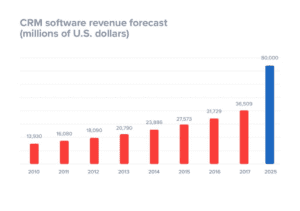
With more and more players entering the market, it has become a hard grind for the insurance companies to exist and make profits. Competition has increased, profits have declined, and there is a constant struggle to gain more and more power. It has created a willingness amongst the experts in trying to excel in customer relationship management (CRM), given how important it is for their business.
With the advent of the 21st century, CRM has gained tremendous traction. It is in fact the fastest growing software market and is expected to cross $80 billion in revenue by the year 2025. In this article, we discuss insurance CRM as a whole, and why do an insurance organization need it to drive their business.

Meaning of Insurance CRM
CRM or Customer Relationship Management is a process of creating a palatable partnership with your customers, which creates value for both parties. In layman’s term, it involves creating a strategy that helps in acquiring, retaining, and partnering with your customers to provide and receive benefits.
Like in any other field, CRM is utilized in the insurance sector as well. Insurance started as a mere attempt to reduce an individual’s risk, and over time it has become one of the largest industries globally.
In the insurance business, everything is primarily dependent on converting potential customers into actual clients. It involves high-velocity sales, and that is the reason why CRM must be adopted gleefully in the mix.
Features of a Worthy Insurance CRM
Certain features must make their presence felt if you want to collaborate CRM with insurance such as–
1. Ability to identify potential clients
What will you do if you don’t have enough clients at your disposal? Therefore the first step is to identify the sources which can help you get your potential customers. It can be via a convenient way like via emails, referrals, social media, phone calls, etc. or the unique ones like campaigns.
What role does CRM play? The first and foremost job is that the CRM integrates with all the sources as mentioned above to prevent any loss of data. it helps in collecting all the potential customers along a single line and helps them to reach you without any hassle whatsoever.
2. Allocating requisite team to the relevant queue
Since you have already collected the leads, the next step would be to allocate personnel to cater to them. Unless the number is terrifyingly low, you would not have the luxury to do it manually.
It is where CRM excels. It allows you to filter the population on various counts like geography, age, etc. and you can customize it as per your choice too. It reduces your efforts and gives you a higher chance of conversion at the same time. You can concentrate on providing them the best service now.
3. Prioritizing your client list
After you have completed the distribution of your leads, it is time that you have the requisite weapons to filter them in various categories as per your priority. Once again, your manual workforce may not be able to do it all alone without wasting their all-important work hours.
Instead, let CRM do it along with their help. Once the basis of categorization is ready, you can then choose high-priority categories. These can depend on the source of entry or on their financial characteristics or any custom characteristics that you define.
4. Providing tools to on-field workers
Most organizations provide ample artillery to their top-ranked warriors. But there is something familiar amongst those who fail; they forget to provide adequate resources to their on-field staff.
Insurance is one sector that needs a bucket load of ground workers.
It is not feasible to provide them all with laptops or even for the team to have access to them all the time. On the other hand, most or all of them have a smartphone. So you must build a mobile-friendly solution which helps them complete all the tasks expected of them.
It will not only come handy for them; it will also help the upper-level managers to get real-time data and utilize it to assess their progress.
5. Automated messaging
You must have come across a term, ‘chatbot,’ and these are becoming popular nowadays. For the uninitiated, these are software that businesses use to send automated replies to their potential customers.
Chatbots allow customers to get instant replies to their inquiries. Not only that, they are a proven performer when it comes to improving customer interactions. A good CRM strategy must include the presence of chatbots wherever applicable.
6. Regular reminders and notifications
A CRM plan should have a constructive way to send regular reminders and notifications to not just your clients, but to your potential customers as well. That way, they won’t miss any vital information or lucrative offers, and you get a chance to convert some of the leads into your clientele.
Steps to create a Custom CRM

If you never had an interaction with a CRM software, there is a possibility that you would struggle to decide the commencement point. To ensure that you don’t, here are some key points that you must remember –
1. Create a list of challenges and requirements for the final product
You are incorporating a CRM software in the mix as you find the existing system to be imperfect. The first step to perfection is chalking down the flaws that you want to get rid of with the help of the new setup. In addition to that, make a list of missing features that need inclusion in the upcoming scheme.
2. Choosing the right vendor with a hold on the insurance sector
Once you have your issues jotted down, the next step would be to find a partner who is willing to solve them on your behalf.
When you are screening possible candidates, you ought to check their previous work experience to understand if they are what they claim and if that is ample for you!
3. Zeroing on the most suitable package
After recognizing your issues and finding a suitable partner capable of getting rid of those, it is time that you choose the best package. It should contain everything that you expect and make sure that there are nifty extras available which can come handy if required.
Why is it important for every insurance company?
CRM is an automated process that is cross-platform in nature. It’s a must for every insurance company and here is why you must get one for yourself –
With regards to customers
- Improvement in conversion
When you switch from manual to automatic, one of the first advantages you get is a faster turnaround time. With the help of CRM, you can now move your leads faster, allocate requisite personnel, cross-sell, and up-sell faster. It will lead to an improvement in conversion rates and reduce the overall time taken.
- Increase in sales and revenue
The primary objective of CRM is to improve customer relationships, thereby enhancing sales in the long run. With a plethora of planning tools and data at its disposal, it is always looking for ways to sell the extra unit. It leads to improvement in revenue for the organization.
- Better distribution of leads
As discussed earlier, CRM uses tools to assign the right personnel to the right customer. Not only that, but it also provides routine assignments to employees automatically, which ensures that the distribution of leads is according to the capability of the employees.
- Higher closure rates
CRM gives you an ability to manage all your tasks, be it within the organization, or handling customers, on a single platform. It is synonymous with better closure rates.

With regards to the workforce
- Simplified onboarding
CRM not only accentuates client onboarding, but it is also a proven performer when it comes to improving the onboarding process of the workforce. It helps the agents to understand what we expect from them and how the organization functions, thereby reducing the time required for settling in.
- Improvement in loyalty
With the help of Customer Relationship Management techniques, you get to track every step minutely. You can remove anything which is not in sync at the very instant, and it leads to higher work satisfaction, which leads to improved loyalty.
- Better sales results in higher motivation to work
CRM is a win-win-win situation for all the parties involved. The customer benefits because he gets timely and relevant service. The organization benefits due to reduced turnover time and improved performance. The workforce benefits due to higher sales, which keeps them motivated to perform better and give more than their cent percent.
Benefits that it offers
CRM offers several advantages to the insurance sector, provided you implement it the way it is ought to be. You get the luxury of better data management, reduced communication gap, and several other key factors to keep you ahead of the competition. If you would like to know more, here is the link to the article discussing them in detail.
Summing Up
The growth of CRM has been stupendous.
In the year 2019, CRM usage increased from 56 percent to a staggering 74 percent. It is a handy tool for the Insurance sector, but it needs a helping hand in the form of a proper strategy and other tools to yield the results that you seek. You can get a pool of data, but it is your workforce who needs to process the data to convert it into useful information.
Insurance being a client-driven industry, you first need to understand what your customers are looking for and how you can satisfy them. After that, cultivate products that are in line with their requirements. How you utilize CRM amongst all these will define your success your failure in the long run!




